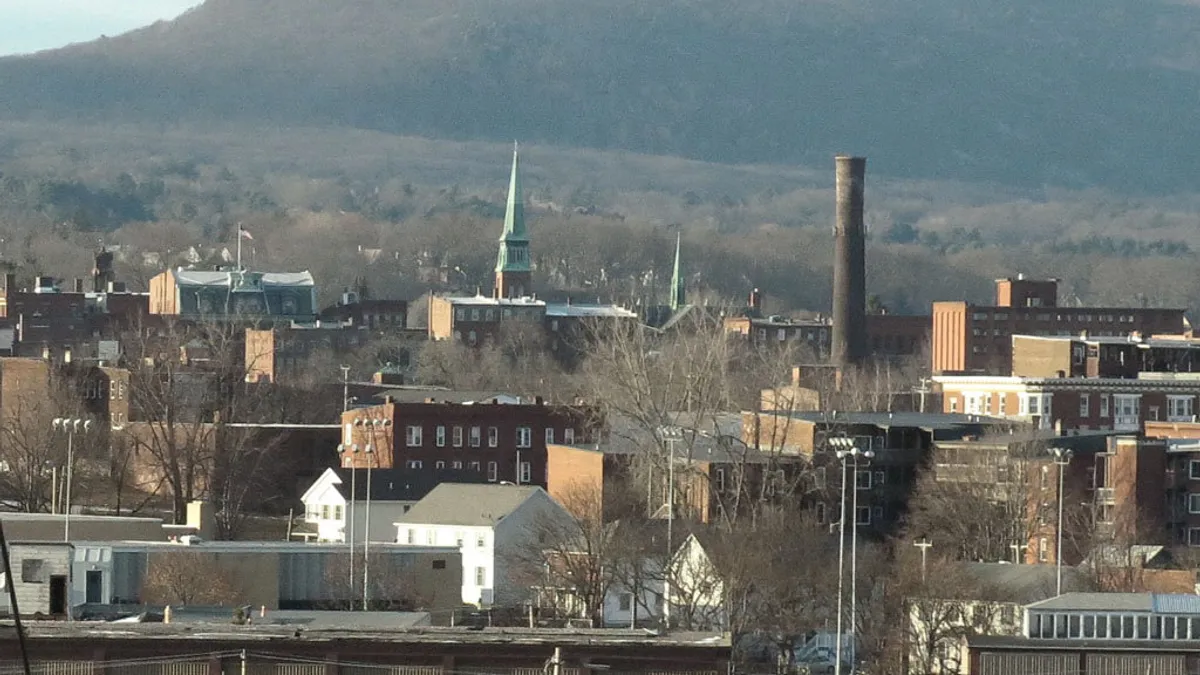For more than 50 years, the Mount Tom Station coal-fired power plant stood on the outskirts of Holyoke, MA, generating energy for the city. It was long blamed for residents' health problems, and by 2009 the plant had lost profitability due to economic trends, which led to its closure in 2014.
Last year marked the start of a new chapter for the power plant, which has been transformed into a solar farm made up of 17,000 solar panels, the largest in Massachusetts. A reuse study funded in part from the state budget found that turning it into a solar farm would be feasible; now known as the Mount Tom Energy Storage System, the facility has a three-megawatt battery storage system.
"This project is the perfect illustration of energy transformation in action — affordable, clean energy replacing traditional fossil fuel power generation," Frank Demaille, president and CEO of ENGIE North America, which partnered with Holyoke Gas & Energy on the project, said in a statement when the storage plan was announced. "Solar energy, optimized by energy storage, is key to a low-carbon, low-cost energy future."
It was local groups such as Neighbor to Neighbor that helped raise awareness of the health issues that the coal-fired plant was alleged to be causing and garnered support for the solar farm. But they also had to try and help plant employees, some of which were not enamored with the idea of losing their jobs and an uncertain future it might bring.
By partnering at the city and state level, young employees were offered job re-training, while older employees who were close to retirement were offered a bridge, meaning they could access savings and pensions early.
"The writing was on the wall that the coal plant was going to shut down because of economic forces, but we really wanted to make sure it happened sooner rather than later," Lena Entin, formerly a lead organizer at Neighbor to Neighbor who is now deputy director at the Toxics Action Center, told Smart Cities Dive. "[People] were invested in environmental impacts but also in the workers and making sure there was a just transition for the city."
For local elected officials, seeing the growth of a collaboration between disparate groups was a slow process, but they were surprised with the results. All noted that initially there was significant opposition among employees to closing the plant, although the economic realities meant it was inevitable.
Meanwhile, the coal plant's owners were reluctant to meet with community activists and agree to their demands, and only after a threat of a public event outside their offices by local groups and a nudge from city government did they relent.
"The biggest takeaway was how activist groups actually came together with everyday citizens who aren't always active and the business community, which doesn't happen very often,” Massachusetts Rep. Aaron Vega, who represents the city in the state House of Representatives, told Smart Cities Dive. “The advocates and business community are usually at odds, and everyday citizens sometimes don't feel like they have enough time to get involved and don't consider themselves activists."
“Whenever we can take steps that assure that we're getting closer to carbon neutrality, that we're making sure we continue to be renewable, is something we want to pursue."

Alex Morse
Holyoke, MA Mayor
Holyoke Mayor Alex Morse said the solar farm will play a big role in helping the city become carbon neutral and totally reliant on renewable energy sources. Already, Holyoke uses hydroelectricity through its dam along the Connecticut River, as well as other solar and geothermal. That use of renewable sources means city residents pay some of the lowest utility fees in New England, Morse said.
"Whenever we can take steps that assure that we're getting closer to carbon neutrality, that we're making sure we continue to be renewable, is something we want to pursue," he told Smart Cities Dive. "Then the energy storage was another feather in the city's cap to make sure we can continue capturing the clean energy off peak hours."
There are still opportunities for further work at the site, too. A 12-acre parcel of land is ripe for development, with the city working with the developer to try and attract a brick-and-mortar business like a manufacturing firm. Morse said if that plan succeeds, it would do even more to help make up the lost tax revenue from the coal plant’s closure.
"Right now, it's the industrial-general zone of the city, so we see that as an opportunity," he said. "We've done the energy storage, we've done the solar, and now it's an opportunity to have a business there that will create jobs and replace at least some of the jobs that were lost and replace some of that lost tax revenue."




















